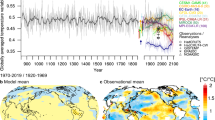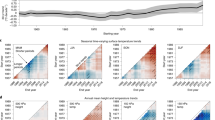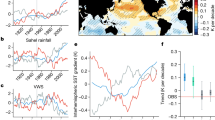Abstract
Certain large, sustained anomalies in European temperatures in the past millennium are probably the result of internal variation. Such internal variations can modulate regional temperatures away from the expected response to greenhouse gas forcing. Here we assess the causes of European summer temperature variability over the past millennium using temperature observations, simulations and reconstructions. We find multidecadal-mean summer temperatures have varied within a span of 1 K, largely controlled by external forcing. By contrast, we find subcontinental variations, described by the temperature contrast between northern and southern Europe (the meridional temperature gradient), vary with a span of 2 K, and are controlled by internal processes. These variations are the result of redistributions of precipitation and cloud cover linked to oscillations in the position of the summer storm track. In contrast to recent twentieth-century winter-time trends, variations of the summer storm track over the past millennium show a weak response to external forcing, and instead are dominated by stochastic internal variability. We argue that the response of European summer temperatures to anthropogenic greenhouse forcing is likely to be spatially modulated by the same stochastic internal processes that have caused periods of cool, wet summers in northern Europe over the last millennium.
This is a preview of subscription content, access via your institution
Access options
Subscribe to this journal
Receive 12 print issues and online access
$259.00 per year
only $21.58 per issue
Buy this article
- Purchase on Springer Link
- Instant access to full article PDF
Prices may be subject to local taxes which are calculated during checkout



Similar content being viewed by others
References
Zorita, E. et al. European temperature records of the past five centuries based on documentary/instrumental information compared to climate simulations. Climatic Change 101, 143–168 (2010).
Adams, J. B., Mann, M. E. & Ammann, C. M. Proxy evidence for an El Nino-like response to volcanic forcing. Nature 426, 274–278 (2003).
Deser, C. et al. Communication of the role of natural variability in future North American climate. Nature Clim. Change 2, 775–779 (2012).
Stott, P. A. et al. Detection and attribution of climate change: a regional perspective. WIREs: Clim. Change 1, 192–211 (2010).
Solomon, A. et al. Distinguishing the roles of natural and anthropogenically forced decadal climate variability. Bull. Am. Meteorol. Soc. 92, 141–156 (2011).
PAGES 2k ConsortiumContinental-scale temperature variability during the past two millennia. Nature Geosci. 6, 339–346 (2013).
Zhang, X., Walsh, J. E., Zhang, J., Bhatt, U. S. & Ikeda, M. Climatology and interannual variability of Arctic cyclone activity: 1948–2002. J. Clim. 17, 2300–2317 (2004).
Dong, B., Sutton, R. T., Woollings, T. & Hodges, K. Variability of the North Atlantic summer storm track: mechanisms and impacts on European climate. Environ. Res. Lett. 8, 034037 (2013).
Trachsel, M. et al. Multi-archive summer temperature reconstruction for the European Alps, AD 1053–1996. Quat. Sci. Rev. 46, 66–79 (2012).
Büntgen, U., Frank, D., Wilson, R., Carrer, M. & Urbinati, C. Testing for tree-ring divergence in the European Alps. Glob. Change Biol. 14, 2443–2453 (2008).
Büntgen, U. et al. Long-term summer temperature variations in the Pyrenees. Clim. Dynam. 31, 615–631 (2008).
McCarroll, D. et al. A 1200-year multiproxy record of tree growth and summer temperature at the northern pine forest limit of Europe. Holocene 23, 471–484 (2013).
Schmidt, G. A. et al. Climate forcing reconstructions for use in PMIP simulations of the last millennium (v1.0). Geosci. Model Dev. 4, 33–45 (2011).
Luterbacher, J., Dietrich, D., Xoplaki, E., Grosjean, M. & Wanner, H. European seasonal and annual temperature variability, trends, and extremes since 1500. Science 303, 1499–1503 (2004).
Mann, M. E. et al. Proxy-based reconstructions of hemispheric and global surface temperature variations over the past two millennia. Proc. Natl Acad. Sci. USA 105, 13252–13257 (2008).
Crowley, T. J. Causes of climate change over the past 1000 years. Science 289, 270–277 (2000).
Schmidt, G. A. et al. Climate forcing reconstructions for use in PMIP simulations of the last millennium (v1.0). Geosci. Model Dev. 4, 33–45 (2011).
Chang, E. K. Are band-pass variance statistics useful measures of storm track activity? Re-examining storm track variability associated with the NAO using multiple storm track measures. Clim. Dynam. 33, 277–296 (2009).
Bender, F. A., Ramanathan, V. & Tselioudis, G. Changes in extratropical storm track cloudiness 1983–2008: observational support for a poleward shift. Clim. Dynam. 38, 2037–2053 (2012).
Stott, P. A., Stone, D. A. & Allen, M. R. Human contribution to the European heatwave of 2003. Nature 432, 610–614 (2004).
Hegerl, G. et al. Influence of human and natural forcing on European seasonal temperatures. Nature Geosci. 4, 99–103 (2011).
Briffa, K. R. et al. Reduced sensitivity of recent tree growth to temperature at high northern latitudes. Nature 391, 678–682 (1998).
McCabe, G. J., Clark, M. P. & Serreze, M. C. Trends in Northern Hemisphere surface cyclone frequency and intensity. J. Climatol. 14, 2763–2768 (2001).
Zahn, M. & von Storch, H. Tracking polar lows in CLM. Meteorol. Z. 17, 445–453 (2008).
Chang, E. K. M., Zheng, C., Lanigan, P. & Yau, A. M. W. Significant modulation of variability and projected change in California winter precipitation by extratropical cyclone activity. Geophys. Res. Lett. 42, 5983–5991 (2015).
Latif, M. et al. Reconstructing, monitoring, and predicting multidecadal-scale changes in the North Atlantic thermohaline circulation with sea surface temperature. J. Clim. 17, 1605–1614 (2004).
Folland, C. K. et al. The summer North Atlantic Oscillation: past, present, and future. J. Clim. 22, 1082–1103 (2009).
Gómez-Navarro, J. J. & Zorita, E. Atmospheric annular modes in simulations over the past millennium: no long-term response to external forcing. Geophys. Res. Lett. 40, 3232–3236 (2013).
Zappa, G., Masato, G., Shaffrey, L., Woollings, T. & Hodges, K. Linking Northern Hemisphere blocking and storm-track biases in the CMIP5 climate models. Geophys. Res. Lett. 41, 135–139 (2014).
Hulme, M., Osborn, T. J. & Johns, T. C. Precipitation sensitivity to global warming: comparison of observations with HadCM2 simulations. Geophys. Res. Lett. 25, 3379–3382 (1998).
McCarroll, D. et al. Blue reflectance provides a surrogate for latewood density of high-latitude pine tree rings. Arct. Antarct. Alp. Res. 34, 450–453 (2002).
Böhm, R. et al. The early instrumental warm-bias: a solution for long central European temperature series 1760–2007. Climatic Change 101, 41–67 (2010).
Giorgetta, M. A. et al. Climate and carbon cycle changes from 1850 to 2100 in MPI-ESM simulations for the Coupled Model Intercomparison Project phase 5. J. Adv. Model. Earth Syst. 5, 572–597 (2013).
Gent, P. R. et al. The community climate system model version 4. J. Clim. 24, 4973–4991 (2011).
Ebisuzaki, W. A method to estimate the statistical significance of a correlation when the data are serially correlated. J. Clim. 10, 2147–2153 (1997).
Zahn, M. & von Storch, H. Decreased frequency of North Atlantic polar lows associated with future climate warming. Nature 467, 309–312 (2010).
Cavicchia, L., von Storch, H. & Gualdi, S. A long-term climatology of medicanes. Clim. Dynam. 43, http://dx.doi.org/10.1007/s00382-013-1893-7 (2013).
Crowley, T. J. & Unterman, M. B. Technical details concerning development of a 1200 yr proxy index for global volcanism. Earth Syst. Sci. Data 5, 187–197 (2013).
Gao, C., Robock, A. & Ammann, C. Volcanic forcing of climate over the past 1500 years: an improved ice core-based index for climate models. J. Geophys. Res. 113, D23111 (2008).
Hansen, J. et al. Climate forcings in Goddard Institute for Space Studies SI2000 simulations. J. Geophys. Res. 107, 4347 (2002).
Vieira, L. E. A., Solanki, S. K., Krivova, N. A. & Usoskin, I. Evolution of the solar irradiance during the Holocene. Astron. Astrophys. 531, http://dx.doi.org/10.1051/0004-6361/201015843 (2011).
Acknowledgements
M.H.G., D.M., G.H.F.Y. and I.R. were supported by European Union FP6 project Millennium 017008 and the Climate Change Consortium of Wales C3W. The work of E.Z. and M.Z. is part of the German Cluster of Excellence CLISAP. M.H.G., D.M. and E.Z. were supported by the PAGES initiative (EuroMed2k), which in turn received support from the US and Swiss National Science Foundations, US National Oceanographic and Atmospheric Administration and the International Geosphere-Biosphere Programme. T. D. James is thanked for support with figures.
Author information
Authors and Affiliations
Contributions
M.H.G.: project planning and design, data analysis, manuscript preparation. E.Z.: data analysis and manuscript preparation. D.M.: project planning and design, data analysis, manuscript preparation. M.Z.: data analysis, manuscript preparation. G.H.F.Y.: project planning, data analysis, manuscript preparation. I.R.: project planning, data analysis, manuscript preparation.
Corresponding author
Ethics declarations
Competing interests
The authors declare no competing financial interests.
Supplementary information
Supplementary Information
Supplementary Information (PDF 1089 kb)
Rights and permissions
About this article
Cite this article
Gagen, M., Zorita, E., McCarroll, D. et al. North Atlantic summer storm tracks over Europe dominated by internal variability over the past millennium. Nature Geosci 9, 630–635 (2016). https://doi.org/10.1038/ngeo2752
Received:
Accepted:
Published:
Issue Date:
DOI: https://doi.org/10.1038/ngeo2752
This article is cited by
-
Spring arctic oscillation as a trigger of summer drought in Siberian subarctic over the past 1494 years
Scientific Reports (2021)
-
Recent atmospheric drying in Siberia is not unprecedented over the last 1,500 years
Scientific Reports (2020)
-
Extratropical cyclones over East Asia: climatology, seasonal cycle, and long-term trend
Climate Dynamics (2020)
-
Current European flood-rich period exceptional compared with past 500 years
Nature (2020)
-
Integrated climate-chemical indicators of diffuse pollution from land to water
Scientific Reports (2018)



